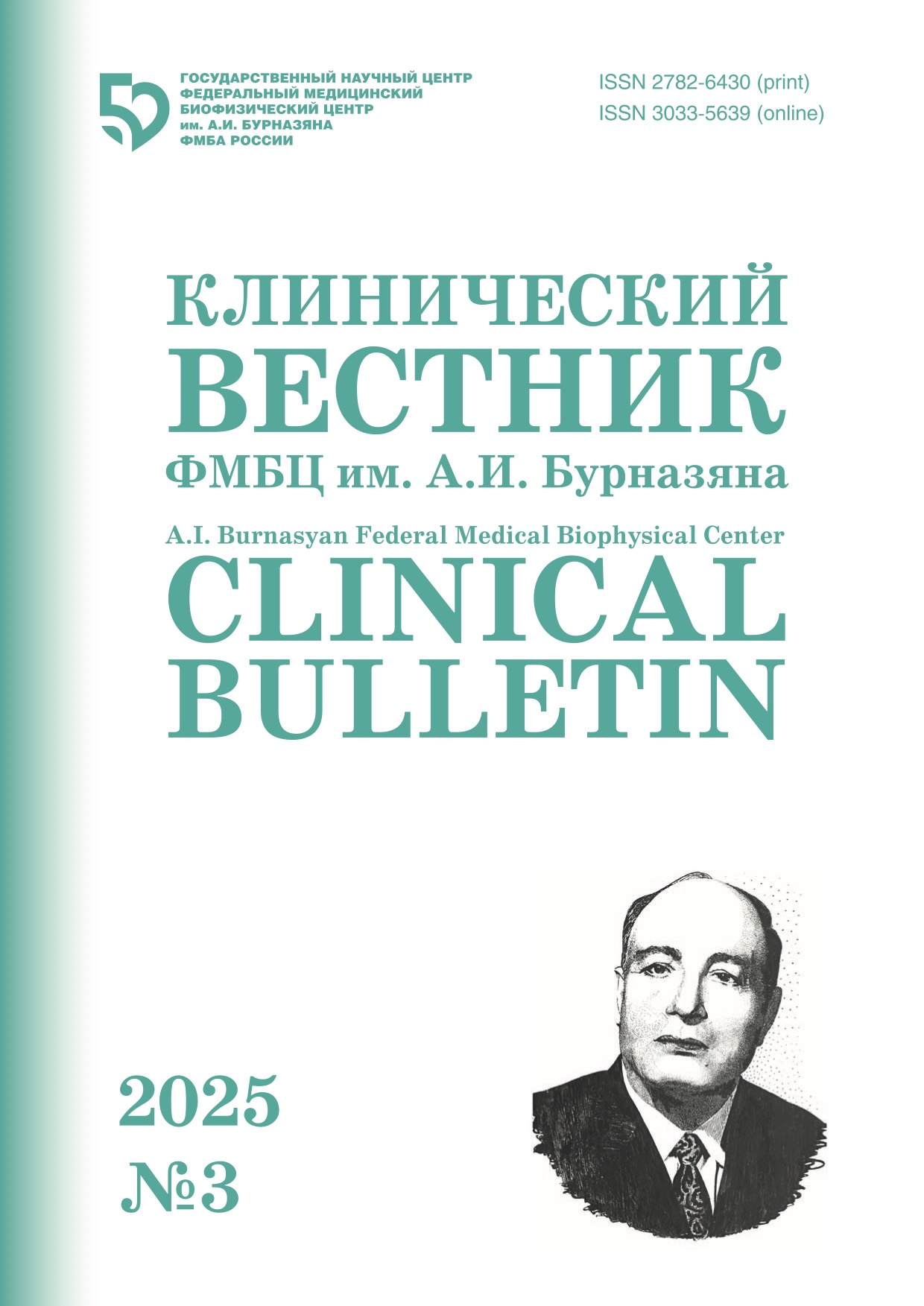A.I. Burnasyan FMBC clinical bulletin. 2025 № 3
F.A. Mavliev¹, D.K. Korovina¹, N.V. Rylova²
Effect of Food Intake on Bioimpedanceometric Parameters
1Volga Region State University of Physical Culture, Sports and Tourism, Kazan, Russia
2International Office, State Research Center – Burnasyan Federal Medical Biophysical Center
of Federal Medical Biological Agency, Moscow, Russiа
Contact person: Rylova Natal’ya Victorovna: rilovanv@mail.ru
Abstract
Bioimpedance analysis is widely used in scientific and clinical practice to assess component body composition. However, it is known that the results of bioimpedance analysis can be influenced by various external factors, including food intake. The purpose of this study was to investigate the nature and extent of changes in bioimpedance parameters after a single meal and to identify possible correlations of these changes with the amount of food and liquid consumed. Male students participated in the study, bioimpedance analysis was performed on the InBody 770 device twice – before and 10 minutes after a meal. The data obtained showed a statistically significant increase in most body composition parameters, especially water volume, protein, muscle and fat-free mass, and mineral content. At the same time, the fat content remained unchanged. Correlation analysis revealed inverse relationships between the volume of food ingested and a number of parameters, including lower limb phase angle. The obtained results emphasize the need for strict standardization of bioimpedance analysis conditions, in particular, taking into account the time and volume of the last meal to ensure correct interpretation of the data
Keywords: bioelectrical impedance analysis, food intake, body composition, phase angle, intracellular water, measurement standardization
For citation: Mavliev FA, Korovina DK, Rylova NV. Effect of Food Intake on Bioimpedanceometric Parameters. A.I. Burnasyan Federal Medical Biophysical Center Clinical Bulletin. 2025.3:14-18. (In Russian) DOI: 10.33266/2782-6430-2025-3-14-18
REFERENCES
- Ward LC Bioelectrical impedance analysis for body composition assessment: reflections on accuracy, clinical utility, and standardisation. Eur J Clin Nutr. 2019;73(2):194–199.
- Kyle UG, Bosaeus I, De Lorenzo AD, Deurenberg P, Elia M, Gomez JM, et al. Bioelectrical impedance analysis – part I: review of principles and methods. Clin Nutr. 2004;23(5):1226–1243. doi:10.1016/j.clnu.2004.06.004. PMID:15380917.
- Korovina D.K., Mavliev F.A. Ocenka gidratirovannosti organizma thekvondistok v den’ vzveshivaniya i v den’ poedinkov, metodom bioimpedansnogo analiza. V: Aktual’nye mediko-biologicheskie problemy sporta i fizicheskoj kul’tury: materialy Mezhdunarodnoj nauchno-prakticheskoj konferencii. Volgograd; 2024. S. 45–48.
- Ward LC, Brantlov S Bioimpedance basics and phase angle fundamentals. Rev Endocr Metab Disord. 2023;24(3):381–391. doi:10.1007/s11154-022-09780-3. PMID:36749540.
- Nikolaev D.V., Smirnov A.V., Bobrinskaya I.G., Rudnev S.G. Bioimpedansnyj analiz sostava tela cheloveka. M.: Nauka; 2009. 392 s.
- Mialich MS, Jmf S, Jordao AA Analysis of body composition: a critical review of the use of bioelectrical impedance analysis. Int J Clin Nutr. 2014;2(1):1–10.
- Androutsos O, Grammatikaki E, Karanikolou A, Reilly J, Edwards CA Impact of eating and drinking on body composition measurements by bioelectrical impedance. J Hum Nutr Diet. 2015;28(2):165–171.
- Hirsch KR, Smith-Ryan AE Effect of acute feeding on raw bioimpedance values and body water estimates in healthy adults: 1970. Med Sci Sports Exerc. 2022;54(9S):586.
- Slinde F, Rossander-Hulthen L Bioelectrical impedance: effect of 3 identical meals on diurnal impedance variation and calculation of body composition. Am J Clin Nutr. 2001;74(4):474–478.
- Tinsley GM, Stratton M, Harty PS, Williams DA., White SJ, Rodriguez C et al. Influence of acute water ingestion and prolonged standing on raw bioimpedance and subsequent body fluid and composition estimates. J Electr Bioimp. 2022;13(1):10.
- Deurenberg P, Weststrate JA, Hautvast JG Changes in fat-free mass during weight loss measured by bioelectrical impedance and by densitometry. Am J Clin Nutr. 1989;49(1):33–36.
- Slinde F, Bark A, Jansson J, Rossander-Hulthen L Bioelectrical impedance variation in healthy subjects during 12 h in the supine position. Clin Nutr. 2003;22(2):153–157.
- Mavliev F.A., Rylova N.V., Korovina D.K. Dinamika pokazatelej bioimpedansnogo analiza posle dozirovannoj fizicheskoj nagruzki. Rossijskij zhurnal sportivnoj nauki: medicina, fiziologiya, trenirovka. 2024;3(2):7–11.
- Yamaguchi S, Inami T et al. Bioimpedance analysis for identifying new indicators of exercise-induced muscle damage. Sci Rep. 2024;14(1):15299.
Conflict of interest. The authors declare no conflict of interest.
Financing. The study had no sponsorship.
Contribution. Article was prepared with equal participation of the authors.
Article received: 13.03.2025. Accepted for publication: 05.04.2025


